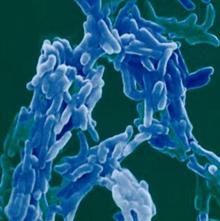A recent study on human genetics on various populations across the world conducted by researchers from the Institut Pasteur and the CNRS has shown how pathogens can shape the patterns of genetic diversity of our immune system over time. Results show that bacteria, fungi and parasites, unlike viruses, appear to have allowed the introduction of mutations in the genes of some proteins of the innate immunity system, thus enabling greater genetic variability. In some cases, these mutations may even constitute an advantage, giving the human host improved resistance to infectious diseases such as leprosy or tuberculosis.
Press release
Paris, july 20, 2009

The researchers’ work demonstrated an extreme degree of similarity between the genes of virus-recognizing TLRs among the various populations across the world; mutations here are very rare and the sequence of these genes is highly conserved. Viruses have therefore exerted very high selective pressure on these proteins over time by precluding them to evolving genetically. On the other hand, the genes of the TLRs which recognize bacteria, fungi or parasites exhibit a much higher degree of variability. It is possible for mutations to accumulate within these genes without it proving critical for the organism. This suggests that the role of these proteins is not essential and more redundant.
This research supports previous observations demonstrating that the small number of known mutations affecting the genes of virus-recognizing TLR receptors are at the origin of rare, serious diseases. This is the case for a mutation affecting the TLR3 gene which has previously been identified as being responsible for encephalitis. Mutations affecting the genes of the other TLR types appear to cause or favor less severe, more common infectious diseases. One mutation that affects the TLR6 gene, for example, is known to be involved in susceptibility to asthma in children.
This research also enabled scientists to demonstrate that a mutation affecting TLR1, a receptor responsible for recognizing bacteria, may actually constitute an advantage! This mutation, found in two out of five people in Europe, prevents the expression of this receptor at the cell surface, and consequently reduces the inflammatory response by 40 to 60%. In previous studies, this mutation was even associated with greater resistance to leprosy and tuberculosis.
The evolutionary approach of this research sheds new light on the question of the relationship between humans and pathogens. Based on the direct analysis of genetic sequences, it opens up new possibilities, to be explored from a clinical, immunological and epidemiological point of view, for a better understanding of susceptibility to certain diseases.
___
*Institut Pasteur/CNRS URA 3012
Picture : Mycobacterium tuberculosis, bacteria responsible of tuberculosis. © Gounon, P. / Institut Pasteur
Source
Evolutionary Dynamics of Human Toll-Like Receptors and Their Different Contributions to Host Defense, PLoS Genetics, July 17, 2009.
Luis B. Barreiro (1,2), Meriem Ben-Ali (1), Hélène Quach (1), Guillaume Laval (1), Etienne Patin (1,3), Joseph K. Pickrell (2), Christiane Bouchier (4), Magali Tichit (4), Olivier Neyrolles (5), Brigitte Gicquel (6), Judith R. Kidd (7), Kenneth K. Kidd (7), Alexandre Alcaïs (3,8), Josiane Ragimbeau (9), Sandra Pellegrini (9), Laurent Abel (3,8,10), Jean-Laurent Casanova (3,8,10), Lluís Quintana-Murci (1)
(1) Institut Pasteur, Human Evolutionary Genetics, CNRS, URA3012, Paris, France,
(2) Department of Human Genetics, University of Chicago, Chicago, Illinois, United States of America,
(3) Laboratory of Human Genetics of Infectious Diseases, Necker Branch, Institut National de la Santé et de la Recherche Médicale U550, Necker Medical School, Paris, France,
(4) Institut Pasteur, Plate-forme Génomique, Pasteur Genopole, Paris, France,
(5) IPBS/CNRS, Toulouse, France,
(6) Institut Pasteur, Mycobacterial Genetics Unit, Paris, France,
(7) Department of Genetics, Yale University School of Medicine, New Haven, Connecticut, United States of America,
(8) University Paris René Descartes, Necker Medical School, Paris, France,
(9) Institut Pasteur, Cytokine Signaling Unit, CNRS, URA1961, Paris, France,
(10) Laboratory of Human Genetics of Infectious Diseases, Rockefeller Branch, The Rockefeller University, New York, New York, United States of America
Contacts
Institut Pasteur Press Office
Marion Doucet or Nadine Peyrolo – + 33 (0)1 45 68 89 28 - marion.doucet@pasteur.fr
CNRS Press Office
presse@cnrs-dir.fr – + 33 (0)1 44 96 51 51


